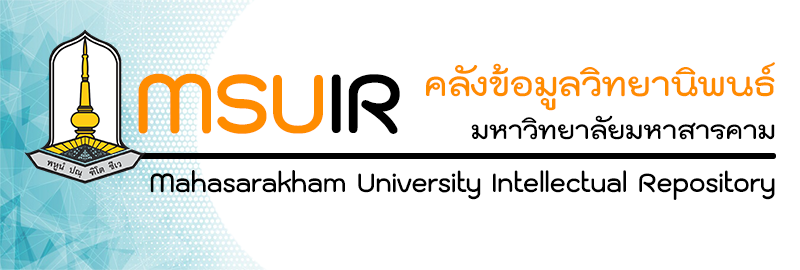Please use this identifier to cite or link to this item:
http://202.28.34.124/dspace/handle123456789/2696Full metadata record
| DC Field | Value | Language |
|---|---|---|
| dc.contributor | Zhou Fang | en |
| dc.contributor | Zhou Fang | th |
| dc.contributor.advisor | Vuthipong Roadkasamsri | en |
| dc.contributor.advisor | วุฒิพงษ์ โรจน์เขษมศรี | th |
| dc.contributor.other | Mahasarakham University | en |
| dc.date.accessioned | 2025-05-07T11:29:47Z | - |
| dc.date.available | 2025-05-07T11:29:47Z | - |
| dc.date.created | 2025 | |
| dc.date.issued | 5/1/2025 | |
| dc.identifier.uri | http://202.28.34.124/dspace/handle123456789/2696 | - |
| dc.description.abstract | This study is an creative research, qualitative research. By integrating Peirce's semiotics and the aesthetics of point, line, and plane, it explores the application of Mazu culture in contemporary painting art. Mazu, as the deity with the highest status and most frequent honors recognized by successive Chinese governments, holds significant cultural and religious importance in China. The first part of this study focuses on analyzing the development and current state of Mazu culture based on the direction of the created works, to understand the origin and evolution of Mazu paintings. The second part employs qualitative research methods, using Peirce's three elements, three Properties, and the concept of infinite semiosis to analyze and extract Mazu cultural symbols. Through detailed analysis of Mazu's stories, duties, beliefs, and influences, it identifies symbol elements that can convey the meaning of Mazu culture. These extracted symbol elements are then reimagined through the aesthetics of point, line, and plane to create paintings that bridge traditional symbolism and contemporary artistic expression.The third part details the creation process of the painting works. It begins with an introduction to the creative sources of the works, followed by the evolution of symbols through semiotics, explaining the creative thinking behind the evolved symbols, and concludes with the creation process and the presentation of the final works. The fourth part showcases the research outcomes, comprehensively introducing the works and evaluations from field experts. The fifth part summarizes the research findings, discussions, and suggestions. The study finds that by interpreting traditional symbols of Mazu culture through semiotics, artists can develop new visual narratives that preserve the essence of Mazu culture while catering to contemporary aesthetics. This approach not only revitalizes traditional cultural symbols but also fosters a dialogue between the past and present, offering new perspectives for the development and inheritance of Mazu culture in contemporary society. The paintings created in this study demonstrate the dynamic interaction between traditional culture and modernity, showing that traditional symbols can be reinterpreted through semiotics and aesthetics to create meaningful contemporary art. This research contributes to the study of Mazu culture and the field of contemporary painting art, showcasing the potential of semiotic analysis and aesthetic principles in the creation of contemporary painting art. | en |
| dc.description.abstract | - | th |
| dc.language.iso | en | |
| dc.publisher | Mahasarakham University | |
| dc.rights | Mahasarakham University | |
| dc.subject | Mazu | en |
| dc.subject | Mazu culture | en |
| dc.subject | Mazu painting | en |
| dc.subject | Symbols | en |
| dc.subject | Aesthetics | en |
| dc.subject.classification | Arts and Humanities | en |
| dc.subject.classification | Agriculture,forestry and fishing | en |
| dc.title | Contemporary Mazu Painting: Symbolized and Idealized Interpretation of Mazu Culture in Fujian Province, China | en |
| dc.title | ภาพวาด Mazu ร่วมสมัย: การตีความเชิงสัญลักษณ์และอุดมคติของวัฒนธรรม Mazu ในมณฑลฝูเจี้ยนประเทศจีน | th |
| dc.type | Thesis | en |
| dc.type | วิทยานิพนธ์ | th |
| dc.contributor.coadvisor | Vuthipong Roadkasamsri | en |
| dc.contributor.coadvisor | วุฒิพงษ์ โรจน์เขษมศรี | th |
| dc.contributor.emailadvisor | vuthipong.r@msu.ac.th | |
| dc.contributor.emailcoadvisor | vuthipong.r@msu.ac.th | |
| dc.description.degreename | Doctor of Philosophy (Ph.D.) | en |
| dc.description.degreename | ปรัชญาดุษฎีบัณฑิต (ปร.ด.) | th |
| dc.description.degreelevel | Doctoral Degree | en |
| dc.description.degreelevel | ปริญญาเอก | th |
| dc.description.degreediscipline | ภาควิชาวัฒนธรรมและการออกแบบ | en |
| dc.description.degreediscipline | ภาควิชาวัฒนธรรมและการออกแบบ | th |
| Appears in Collections: | Faculty of Fine - Applied Arts and Cultural Science | |
Files in This Item:
| File | Description | Size | Format | |
|---|---|---|---|---|
| 63010662018.pdf | 12.76 MB | Adobe PDF | View/Open |
Items in DSpace are protected by copyright, with all rights reserved, unless otherwise indicated.

